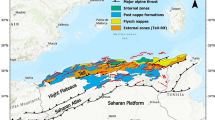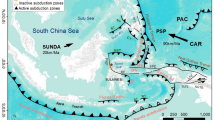Abstract
In the present work I investigate the compatibility of the Abrahamson et al. (Earthq Spectra 32:23–44, 2015) and Zhao et al. (Bull Seismol Soc Am 96:898–913, 2006a) ground-motion prediction equations (GMPEs), developed using non-Greek data from subduction earthquakes, with the magnitude, distance and site scaling suggested by a Greek dataset from subduction, within-slab, earthquakes. The dataset is comprised of recordings from force-balance accelerometers as well as broadband seismometers. The motivation for this study comes from (a) the relatively small number of recordings from large subduction, within-slab, events which to a certain extent limits the applicability and accuracy of the regional subduction GMPEs and (b) the necessity of capturing the epistemic uncertainty in the probabilistic seismic hazard studies for the broader Aegean area, which is currently misrepresented due to the small number of available regional or properly adjusted worldwide ground-motion prediction models. For the Abrahamson et al. (2015) model, the analysis shows that the magnitude scaling implied by the dataset requires moderate adjustments to the magnitude terms. The study of intra-event residuals with distance revealed strong positive trends for the back- and negative trends for the fore-arc data, especially at short periods. The original analysis and the evaluation of the adjusted Zhao et al. (2006a) model revealed that the events in the deeper parts of the subduction (D > 140 km) introduce a significant bias to the model, which results in unrealistically high spectral values for events that occur in that shallower parts of the subduction. Consequently, the applicability of the proposed adjusted Zhao et al. (2006a) model, should be limited to events with D < 125 km. The adjusted Abrahamson et al. (2015) and to a certain extend Zhao et al. (2006a) along with the Skarlatoudis et al. (Bull Seismol Soc Am 103:1952–1968, 2013) GMPEs, form a suite of models that accurately describe the ground motions for the Hellenic subduction. The use of these models in future probabilistic seismic hazard studies in the Hellenic subduction zone will adequately represent the current knowledge of subduction GMPEs and result in more realistic estimates of the seismic hazard in the area.











Similar content being viewed by others
References
Abrahamson NA, Youngs RR (1992) A stable algorithm for regression analyses using the random effects model. Bull Seismol Soc Am 82:505–510
Abrahamson N, Gregor N, Addo K (2015) BC Hydro ground motion prediction equations for subduction earthquakes. Earthq Spectra 32:23–44
Aristotle University of Thessaloniki Seismological Network (1981) Permanent regional seismological network operated by the Aristotle University of Thessaloniki. International Federation of Digital Seismograph Networks. Other/Seismic Network. doi:10.7914/SN/HT
Atkinson GM, Boore DM (2003) Empirical ground-motion relations for subduction zone earthquakes and their application to Cascadia and other regions. Bull Seismol Soc Am 93:1703–1729
Beyer K, Bommer JJ (2006) Relationships between median values and between aleatory variabilities for different definitions of the horizontal component of motion. Bull Seismol Soc Am 96:1512–1522
Boore DM (2010) Orientation-independent, non geometric-mean measures of seismic intensity from two horizontal components of motion. Bull Seismol Soc Am 100:1830–1835
Boore DM, Skarlatoudis AA, Margaris BN, Papazachos CB, Vendouzi Ch (2009) Along-arc and back-arc attenuation and source spectrum for the intermediate-depth 18 January, 2006, M6.7 Kythera, Greece, Earthquake. Bull Seismol Soc Am 99:2410–2434
Boore DM, Stewart JP, Seyhan E, Atkinson GM (2014) NGA-West2 equations for predicting PGA, PGV, and 5% damped PSA for shallow crustal earthquakes. Earthq Spectra 30(3):1057–1085
Essen K, Braatz M, Cerrana L, Friederich W, Meier T (2009) Numerical modeling of seismic wave propagation along the plate contact of the Hellenic Subduction Zone-the influence of a deep subduction channel. Geophys J Int 179:1737–1756
Furumura T, Kennet BLN (2005) Subduction zone guided waves and the heterogeneity structure of the subducted plate: intensity anomalies in northern Japan. JGR. doi:10.1029/2004JB003486
International Seismological Centre (2013) On-line bulletin. International Seismological Centre, Thatcham. http://www.isc.ac.uk
LePichon X, Angelier J (1979) The Hellenic arc and trench system: a key to the neotectonic evolution of the eastern Mediterranean area. Tectonophysics 60:1–42
NEHRP (1994) Recommended provisions for seismic regulations for new buildings and other structures, part 1: provisions. FEMA 222A Building Seismic Safety Council, Washington, DC, 290 pp
Papazachos BC (1990) Seismicity of the Aegean and surrounding area. Tectonophysics 178:287–308
Papazachos BC (1996) Large seismic faults in the Hellenic arc. Ann Geofis 39:891–903
Papazachos BC, Comninakis PE (1969) Geophysical features of the Greek island arc and eastern Mediterranean ridge, Seance de la conference reunie a Madrid, 1–12 September 1969. Comptes Rendus 16:74–75
Papazachos BC, Comninakis PE (1971) Geophysical and tectonic features of the Aegean arc. J Geophys Res 76:8517–8533
Papazachos BC, Karakostas BG, Papazachos CB, Scordilis EM (2000) The geometry of the Wadati–Benioff zone and lithospheric kinematics in the Hellenic arc. Tectonophysics 319:275–300
Scasserra G, Stewart JP, Bazzurro P, Lanzo G, Mollaioli F (2009) A comparison of NGA ground-motion prediction equations to Italian data. Bull Seismol Soc Am 99:2961–2978
Skarlatoudis AA, Papazachos CB, Margaris BN, Papaioannou Ch, Ventouzi Ch, Vamvakaris D, Bruestle A, Meier T, Friederich W, Stavrakakis G, Taymaz T, Kind R, Vafidis A, Dahm T, the EGELADOS Group (2009) Combination of strong-and weak-motion recordings for attenuation studies: the case of the January 8, 2006 Kythera intermediate-depth earthquake. Bull Seismol Soc Am 99:694–704
Skarlatoudis AA, Papazachos CB, Margaris BN, Ventouzi Ch, Kalogeras I, the EGELADOS Group (2013) Ground motion prediction equations of intermediate-depth earthquakes in the Hellenic arc, southern Aegean subduction area. Bull Seismol Soc Am 103:1952–1968
SSHAC (Senior Seismic Hazard Analysis Committee, RJ Budnitz, Chairman, G Apostolakis, DM Boore, LS Cluff, KJ Coppersmith, CA Cornell, PA Morris) (1997) Recommendations for probabilistic seismic hazard analysis—guidance on uncertainty and use of experts. U.S. Nuclear Regulatory Commission Report, NUREG/CR-6372, Washington
Stewart JP, Klimis N, Savvaidis A, Theodoulidis N, Zargli E, Athanasopoulos G, Pelekis P, Mylonakis G, Margaris B (2014) Compilation of a local Vs profile database and its application for inference of V S30 from geologic- and terrain-based proxies. Bull Seismol Soc Am 104:2827–2841
Vamvakaris D (2010) Contribution to the study of the time-dependent seismic hazard. PhD thesis, Aristotle University of Thessaloniki, 503 pp (in Greek)
Wessel P, Smith WHF, Scharroo R, Luis JF, Wobbe F (2013) Generic mapping tools: improved version released. EOS Trans AGU 94:409–410
Zhao JX, Zhang J, Asano A, Ohno Y, Oouchi T, Takahashi T, Ogawa H, Irikura K, Thio HK, Somerville P, Fukushima Y, Fukushima Y (2006a) Attenuation relations of strong motion in japan using site classification based on predominant period. Bull Seismol Soc Am 96:898–913
Zhao JX, Irikura K, Zhang J, Fukushima Y, Somerville PG, Asano A, Ohno Y, Oouchi T, Takahashi T, Ogawa H (2006b) An empirical site-classification method for strong-motion stations in Japan using H/V response spectral ratio. Bull Seismol Soc Am 96:914–925
Acknowledgements
I am grateful to GEOFON, the Seismological Station of Aristotle University of Thessaloniki, the Greek Public Power Corporation, and the Astronomical Observatory of Larissa for their data contribution. I would like to thank Mr. Jeff Bayless for his fruitful comments. Special thanks to Dr David M. Boore, for his thorough reading of the manuscript. His comments significantly improved the quality of the manuscript. I would also like to thank the two anonymous reviewers for their valuable reviews.
Author information
Authors and Affiliations
Corresponding author
Rights and permissions
About this article
Cite this article
Skarlatoudis, A.A. Applicability of ground-motion prediction equations to a Greek within-slab earthquake dataset. Bull Earthquake Eng 15, 3987–4008 (2017). https://doi.org/10.1007/s10518-017-0140-8
Received:
Accepted:
Published:
Issue Date:
DOI: https://doi.org/10.1007/s10518-017-0140-8




